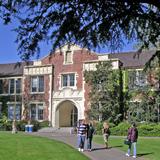- Mendocino College serves the educational needs of our students and our community by providing academic programs, transfer preparation, vocational training, lifelong learning opportunities and student support.
School Highlights
Mendocino College serves 5,738 students (14% of students are full-time).
The college's student-teacher ratio of 24:1 is lower than the state community college average of 32:1.
Minority enrollment is 57% of the student body (majority Hispanic), which is less than the state average of 77%.
Quick Facts (2025-26)
- Enrollment: 5,738 students
- In-state tuition: $1,422
- Out-state tuition: $5,892
- Acceptance Rate: 75%
- Student-teacher ratio: 24:1
- Minority enrollment: 57%
- Source: Integrated Postsecondary Education Data System (IPEDS)
School Overview
The teacher population of 243 teachers has stayed relatively flat over five years.
Mendocino College
(CA) Community College Avg.
Carnegie Classification
Associate's Colleges: High Transfer-High Nontraditional
Baccalaureate/Associate's Colleges: Associate's Dominant
Institution Level
At least 2 but less than 4 years
At least 2 but less than 4 years
Institution Control
Public
Public
Total Faculty
243 staff
315 staff
School Calendar
Student Body
The student population of Mendocino College has grown by 44% over five years.
The student-teacher ratio of 24:1 has increased from 14:1 over five years.
The Mendocino College diversity score of 0.66 is less than the state average of 0.70. The school's diversity has grown by 6% over five years.
Total Enrollment
5,738 students
9,796 students
Student-Teacher Ratio
24:1
32:1
# Full-Time Students
830 students
1,259 students
# Part-Time Students
4,908 students
8,537 students
# Enrollment Undergraduate
573 students
242 students
# Full-Time Undergraduate Students
830 students
1,250 students
# Full-Time Graduate Students
n/a
63 students
# Part-Time Undergraduate Students
4,908 students
8,299 students
# Part-Time Graduate Students
n/a
10 students
Total Dormitory Capacity
n/a
121 students
% American Indian/Alaskan
6%
n/a
% Asian
3%
13%
% Hispanic
38%
47%
% Black
2%
7%
% White
43%
23%
% Hawaiian
n/a
1%
% Two or more races
1%
5%
% Non Resident races
n/a
1%
% Unknown races
6%
3%
Diversity Score
0.66
0.70
College Completion Rate (Students who graduate in less than 4 years)
31%
42%
College Completion Rate (Students who graduate in 4 years or more than 4 years)
n/a
43%
Average Graduate Earnings (10 Years)
$29,200
$34,700
Tuition and Acceptance Rate
The public in-state tuition of $1,422 is less than the state average of $1,516. The in-state tuition has stayed relatively flat over four years.
The public out-state tuition of $5,892 is less than the state average of $6,779. The out-state tuition has declined by 26% over four years.
In-State Tuition Fees
$1,422
$1,516
Out-State Tuition Fees
$5,892
$6,779
% Students Receiving Some Financial Aid
81%
85%
Median Debt for Graduates
$10,500
$10,500
Median Debt for Dropouts
$9,075
$6,239
Acceptance Rate
75%
93%
Source: 2024 (or latest year available) Integrated Postsecondary Education Data System (IPEDS) , School Administrators
School Notes
- The Mendocino-Lake Community College District was formed in September 1972 by vote of the citizens of the Anderson Valley, Laytonville, Potter Valley, Round Valley, Ukiah, and Willits Unified School Districts. Planning for the development of the initial offerings of the College occurred in the Spring of 1973, with the first classes offered in July 1973. our new Ukiah Campus has 20,000 sq. ft. Science Complex. This new facility, along with our state-of-the-art Center for Visual and Performing Arts, Athletic Complex, Lowery Library building, and Vocational Education facility, offer students excellent resources to pursue their goals. Mendocino College is accredited by accrediting Commission for Community and Junior Colleges of the Western Association of Schools and Colleges.
Frequently Asked Questions
How much does Mendocino College cost?
Mendocino College's tuition is approximately $1,422 for In-State students and $5,892 for Out-State students.
What is the acceptance rate of Mendocino College?
The acceptance rate of Mendocino College is 75%, which is lower than the state average of 93%.
Recent Articles

The Rise of Technical and Vocational Training in 2025
Explore the 2025 surge in technical and vocational training—enrollment, policy, costs, and why this path is gaining ground for students and parents.

Stackable Credentials: How Community Colleges Advance Careers
Discover how community colleges use stackable credentials to build career pathways, boost earnings, and enable lifelong learning in 2025.

High-Paying Jobs You Can Get with a Community College Degree
Discover top high-paying careers you can launch in 2025 with a community college (associate) degree and high-growth credentials in tech, healthcare and trades.










